

The Rigi Railway
The first European rack mountain railway: the curious line which runs from Vitznau, up the Rigi, to Kulm
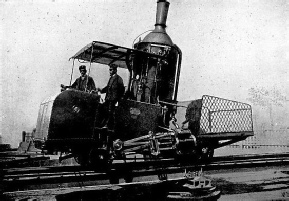
THE FIRST TYPE OF LOCOMOTIVE, with vertical boiler, used on the Rigi Railway.
WHEN the possibility of moving wheeled vehicles along a pair of rails by the aid of the steam engine first was discussed it was considered quite impracticable for sufficient friction to be produced between the wheel and the rail to propel the locomotive and the train. Bearing in mind the small area of contact between the two surfaces, this feeling, in the days when the locomotive was young, is quite excusable. It was held to be imperative that the locomotive wheels should be provided with teeth or studs disposed around the peripheries of the wheels and engaging with holes in the track to secure locomotion.
Accordingly, when John Blenkinsop laid down a railway at the Middleton Collieries, near Leeds, in 1811, he introduced a rail carrying corrugated teeth, outside one of the track rails, with which a driving wheel, mounted outside the carrying wheel, geared. Two years later Blackett, at the Wylam Collieries, argued that Blenkinsop was wrong in his contentions, and that a train could be impelled under adhesion alone providing the grade was not too steep. He proved his theories in a practical manner, with the result that the Blenkinsop tooth system became superseded, and Stephenson, when he directed his energies towards the perfection of the steam locomotive, adopted the adhesive principle.
Although Blenkinsop was proved to be wrong in one phase of the argument, he unwittingly offered the railway engineer a means of overcoming gradients which are too steep to be worked under adhesion. He conceived the rack railway, which now enables the masses to indulge in the sport of mountaineering in safety, luxury, and comfort. Blenkinsop’s rack railway was torn up -
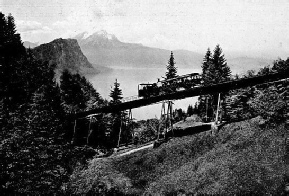
TRAIN CROSSING THE SCHNURTOBEL BRIDGE, the longest on the line.
But although Marsh indicated the possibilities of the rack railway, it was Switzerland which brought the idea to an advanced and perfected stage of development. This was only to be expected, seeing that the “playground of Europe” is vitally dependent upon its tourist traffic. Obviously, the more attractions it can offer to visitors the heavier must be its revenue from this source. Tourists will travel miles to enjoy a “magnificent panorama”, and what better coign of vantage is possible than a mountain top whence are unfolded rolling vistas of glacier, lake, river, and snow-
Still, in Switzerland, this movement was born independently of America. While Sylvester Marsh was striving to secure his concession for the Mount Washington railway, Mr. Nicholas Riggenbach, who took the first steam locomotive into Switzerland in 1847, and who was locomotive superintendent of the Central Swiss Railway in Olten, took out a patent on August 12th, 1863, for a new system of track and locomotives for the ascent of mountains -
When this railway was completed naturally it became an object of interest among engineers. Among these were Messrs. Naeff and Zschokke. They were impressed with the possibilities of the idea, and, joining forces with Riggenbach, it was decided to test it upon a comprehensive scale -
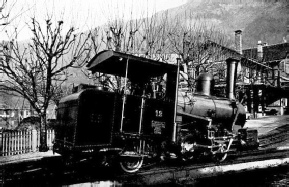
THE LATEST TYPE OF LOCOMOTIVE in use on the Rigi Railway.
Thereupon Riggenbach, Naeff, and Zschokke sought a concession to provide the Rigi with a mountain railway, since it was realised that this peak offered the most promising opportunity to sound the public attitude towards such facilities. The requisite powers were obtained, and Yitznau, at the foot of the mountain, on the shores of Lake Lucerne, was selected as the lower terminal. From that point the line follows a winding ascent to Kulm, at an altitude of 5,900 feet, the total length of the line, which is of standard gauge, being 4·38 miles. The maximum gradient was set down at 20 per cent. -
The rack rail designed by Riggenbach differed from that used by Marsh on the Mount Washington railway, and was a distinct improvement thereon. It was placed centrally between the running rails, and was formed of two channel irons 4¾ inches deep by 2⅜ inches wide, the vertical web being ½ inch, and the flanges 2/5 inch thick. These two channel irons are spaced 5 inches apart, and the teeth of wrought iron are riveted into them at each end. Instead of using round teeth, as Marsh adopted, Riggenbach preferred the taper form which experience has shown to be preferable, inasmuch as it not only ensures safe locking of the gear at different depths, but resists more efficiently the tendency of the gear-
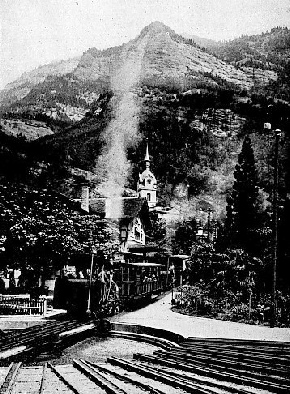
VITZNAU, the lower terminus, showing turntable and siding tracks.
The first locomotive, like the rack, had to be designed especially for the work, and was of unusual design. It was constructed at the Olten works of the Central Railway, with which Riggenbach was associated, and comprised a vertical boiler, set at such a rake to the horizontal as to reduce as far as possible the variations in water level arising from the differences in the gradients which had to be negotiated. The boiler was mounted on a four-
The carriage -
After some eleven years’ service the vertical boiler was abandoned in favour of the horizontal type. Similar considerations concerning changing levels of the water arising from the differences in the gradients had to be borne in mind, and this gives the engine the appearance of tilting forward when on a level track. In the latest Rigi locomotives the cylinders are placed at the leading end, outside the frames, the driving cog-
Travelling upon the Rigi railway cannot be said to be excessively fast, seeing that it averages about 4·7 miles per hour with an average load of 25 to 28 tons. Therefore any qualms on the part of the timorous are unnecessary. To overcome the 3,937 feet difference in altitude between Yitznau and Kulm 74 minutes are occupied in either direction. This may seem slow; but before the coming of the railway the climb involved a tedious, fatiguing toil afoot of 3½ hours.
The railway was completed in 1871 and proved an instant success. The novelty of mountaineering by rail proved irresistible, and the novelty never has worn off so far as the Rigi is concerned. Now more than 120,000 passengers are carried up and down in the course of the year. The ascent costs about 5s. 10d.; the descent 50 per cent. less. In summer ten trains are run daily in each direction, and if the exigencies so demand the total may be raised to eighteen, enabling some 600 passengers to be sent to and fro in the day.
The Rigi railway, being the first of its character in Europe, always has compelled historic interest, but since the first train crawled to the summit of the mountain in 1871 mountain peaks innumerable have been subjugated by the rack railway, operated both by steam and electricity.
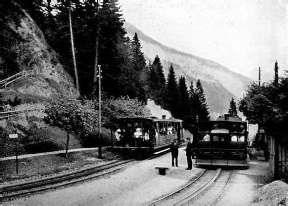
ROMITI STATION. Where the ascending and descending trains pass.
You can read more on
and
and
on this website.